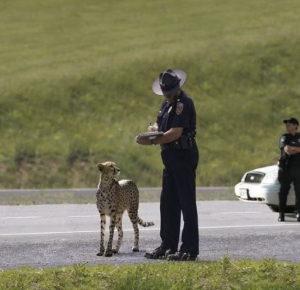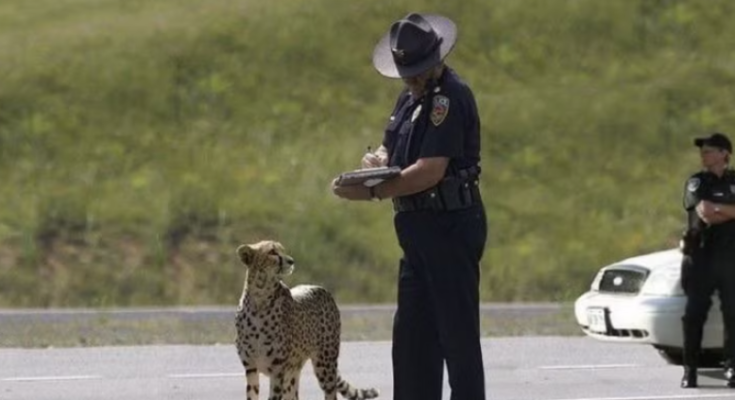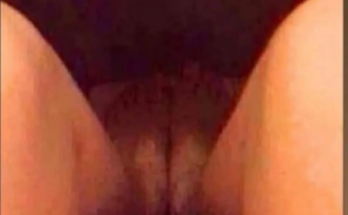Cheetah and the Police
The call came in just after dawn: “Exotic animal loose in the city. Suspected cheetah. Possible danger to public.”
At first, the dispatcher thought it was a prank. A cheetah? In a quiet suburban neighborhood? But within minutes, patrol cars were circling an elementary school on the edge of town. Children on their way to morning classes had seen a blur of gold and black streak across the playground, vaulting the chain-link fence in a single, effortless bound.
By the time officers arrived, the big cat had disappeared into the nearby streets.
The Chase Begins
Officer Daniels was first on the scene, his cruiser headlights sweeping through empty intersections. He’d been on the force for 15 years, but nothing prepared him for the sight of a cheetah slipping out from between two parked cars, muscles rippling under its spotted coat. For a second, Daniels froze—the animal’s amber eyes locked onto his, assessing him not as a cop but as another creature in its territory.
Then, in a flash, it darted down the street. Daniels hit the siren.
Within minutes, three more squad cars joined, attempting to corral the animal. But corralling a cheetah was nothing like cornering a fleeing suspect. It didn’t zigzag nervously or stumble in panic. It moved with grace, weaving between alleys and side streets, faster than the police cruisers could manage in tight spaces. Every so often, it would pause, turn its head, and watch as if taunting them.
Public Panic
Word spread fast. Parents pulled their children indoors. News crews arrived, helicopters hovering above, cameras zooming in on the surreal chase below. A cheetah in the middle of the city—was it an escaped zoo animal? An exotic pet gone rogue?
On social media, speculation exploded: “It’s part of a circus!” … “It must have been smuggled in!” … “Release the hounds!” Others simply posted videos of the cheetah darting through intersections, its speed unmatched by anything mechanical, its beauty undeniable even in chaos.
The city was on edge, torn between awe and fear.
The Dilemma for Police
Inside the command center, Chief Alvarez faced an impossible decision. The cheetah was dangerous if provoked, but no attacks had been reported. Should they tranquilize it? Risk a live capture? Or, as some urged, authorize lethal force before someone was hurt?
But Alvarez hesitated. “Look at it,” she said to her officers, replaying footage from a traffic camera. “It’s not attacking. It’s running. It looks… lost.”
Still, a predator in a city could not be ignored. A team of animal control experts was called in, but they wouldn’t arrive for another hour. Until then, the police had to contain the situation.
A City Transformed
As the chase stretched on, the city seemed to slow down. Streets were blocked off. Buses were rerouted. Crowds gathered behind barricades, watching as the cheetah slipped through urban landscapes like a ghost of the wild. Children pointed in wonder, while parents clutched them tighter, caught between admiration and fear.
For a moment, it was as if nature itself had invaded civilization, a reminder that concrete and glass were never meant to fully keep the wild at bay.
Officer Daniels’ Close Encounter
In one tense moment, Daniels found himself face-to-face with the animal again. This time, the cheetah had cornered itself in a dead-end alley, panting lightly, its chest heaving. Daniels stepped out of his car slowly, hands raised not in authority but in caution.
He could feel his heart pounding. He wasn’t looking at a criminal; he was looking at an apex predator, one that had no idea why sirens screamed and cameras clicked all around it.
The cheetah crouched low, its tail swishing. For a second, Daniels thought it might leap. Instead, it bolted—vaulting over a six-foot fence as if it were nothing.
Daniels exhaled, shaken but strangely moved. “It’s not hunting us,” he told his radio. “It’s just trying to get free.”
The Turning Point
Finally, animal control arrived with tranquilizer rifles and transport cages. But by now, the chase had drawn the cheetah toward the outskirts of town, near an industrial zone where warehouses gave way to open fields.
There, for the first time, the animal seemed to relax. It slowed, stretched its body, and stood tall against the horizon, framed by the rising sun. For a brief moment, everyone watching—from officers to civilians—saw not a threat, but raw, breathtaking majesty.
The shots were fired—soft puffs from the tranquilizer guns. The cheetah flinched, then stumbled, then slowly lowered itself to the grass. Within minutes, it was asleep, chest rising and falling steadily.
Aftermath
The mystery unraveled quickly. The cheetah had escaped from a private collector’s estate just outside the city. The owner had been keeping several exotic animals without proper permits, in violation of federal and state law.
The police, once finished with the chase, now faced a new task: arresting the man responsible and ensuring the safety of the other animals under his care. For the city, relief washed over like a wave. Schools reopened, traffic resumed, and life returned to normal. But the memory of a cheetah running through suburban streets would not fade easily.
Reflection
In the days that followed, debates erupted. Some condemned the owner for endangering lives. Others criticized the police for treating the animal like a suspect instead of a victim. And many more simply reflected on what it meant to see such a creature out of its element.
For Officer Daniels, the moment in the alley lingered. He remembered the way the cheetah’s eyes had met his—not with malice, but with confusion, maybe even fear. It was a reminder that policing isn’t always about criminals and laws. Sometimes, it’s about bridging the fragile line between human order and the untamable wild.
Conclusion
The story of the cheetah and the police became a local legend, told for years to come. Parents recounted it to their children, teachers used it as a lesson about wildlife and responsibility, and the city carried the strange pride of having witnessed something both terrifying and magnificent.
It wasn’t just a chase. It was a moment where humanity was forced to confront its relationship with nature, to recognize that the wild cannot be caged forever—and when it escapes, we are left humbled, staring into the eyes of something older, faster, and freer than ourselves.
And somewhere, in the quiet of an animal sanctuary far from the city, the cheetah slept under open skies, no longer a fugitive but a symbol of a day when the police, the public, and a predator all crossed paths in a story none would ever forget.




